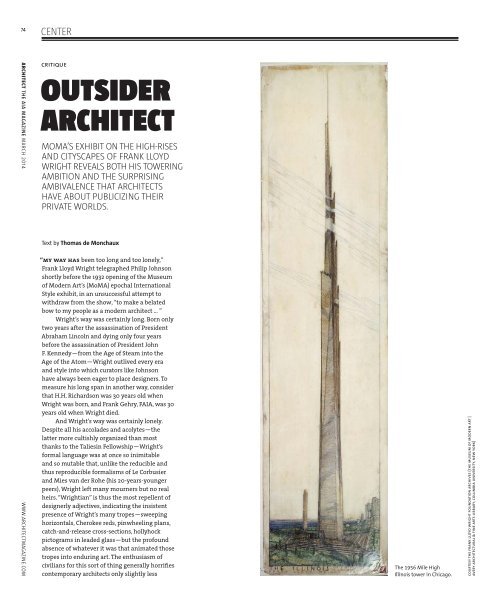Architect 2014-03.pdf
Create successful ePaper yourself
Turn your PDF publications into a flip-book with our unique Google optimized e-Paper software.
74<br />
CENTER<br />
ARCHITECT THE AIA MAGAZINE MARCH <strong>2014</strong> WWW.ARCHITECTMAGAZINE.COM<br />
CRITIQUE<br />
OUTSIDER<br />
ARCHITECT<br />
MOMA’S EXHIBIT ON THE HIGH-RISES<br />
AND CITYSCAPES OF FRANK LLOYD<br />
WRIGHT REVEALS BOTH HIS TOWERING<br />
AMBITION AND THE SURPRISING<br />
AMBIVALENCE THAT ARCHITECTS<br />
HAVE ABOUT PUBLICIZING THEIR<br />
PRIVATE WORLDS.<br />
Text by Thomas de Monchaux<br />
“MY WAY HAS been too long and too lonely,”<br />
Frank Lloyd Wright telegraphed Philip Johnson<br />
shortly before the 1932 opening of the Museum<br />
of Modern Art’s (MoMA) epochal International<br />
Style exhibit, in an unsuccessful attempt to<br />
withdraw from the show, “to make a belated<br />
bow to my people as a modern architect … ”<br />
Wright’s way was certainly long. Born only<br />
two years after the assassination of President<br />
Abraham Lincoln and dying only four years<br />
before the assassination of President John<br />
F. Kennedy—from the Age of Steam into the<br />
Age of the Atom—Wright outlived every era<br />
and style into which curators like Johnson<br />
have always been eager to place designers. To<br />
measure his long span in another way, consider<br />
that H.H. Richardson was 30 years old when<br />
Wright was born, and Frank Gehry, FAIA, was 30<br />
years old when Wright died.<br />
And Wright’s way was certainly lonely.<br />
Despite all his accolades and acolytes—the<br />
latter more cultishly organized than most<br />
thanks to the Taliesin Fellowship—Wright’s<br />
formal language was at once so inimitable<br />
and so mutable that, unlike the reducible and<br />
thus reproducible formalisms of Le Corbusier<br />
and Mies van der Rohe (his 20-years-younger<br />
peers), Wright left many mourners but no real<br />
heirs. “Wrightian” is thus the most repellent of<br />
designerly adjectives, indicating the insistent<br />
presence of Wright’s many tropes—sweeping<br />
horizontals, Cherokee reds, pinwheeling plans,<br />
catch-and-release cross-sections, hollyhock<br />
pictograms in leaded glass—but the profound<br />
absence of whatever it was that animated those<br />
tropes into enduring art. The enthusiasm of<br />
civilians for this sort of thing generally horrifies<br />
contemporary architects only slightly less<br />
The 1956 Mile High<br />
Illinois tower in Chicago.<br />
COURTESY THE FRANK LLOYD WRIGHT FOUNDATION ARCHIVES (THE MUSEUM OF MODERN ART |<br />
AVERY ARCHITECTURAL & FINE ARTS LIBRARY, COLUMBIA UNIVERSITY, NEW YORK)


















